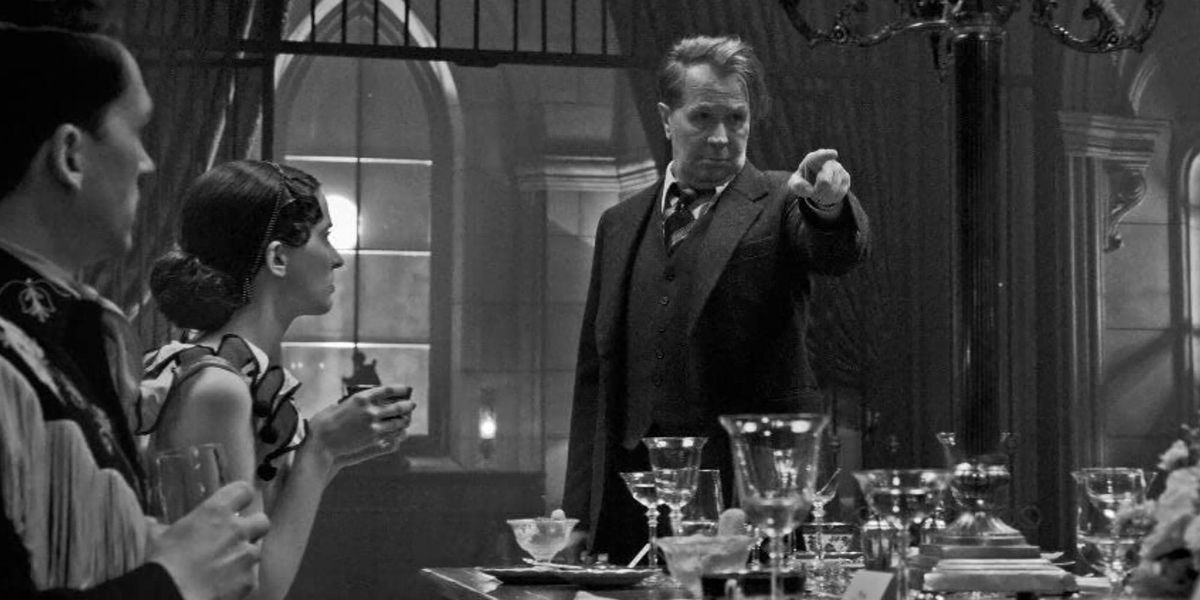There are two aspects to David Fincher’s Mank that make it a more enjoyable piece of December prestige cinema than you might expect. The first is Gary Oldman, investing the wracked and tortured physique of Citizen Kane scribe Herman “Mank” Mankiewicz with a fulsomely entertaining bonhomie that wraps his deeply dark cynicism in a brittle coating of snappy comedy. This is a guy who makes rooms come to life just by his being there, even though he might round off a story by vomiting or passing out after one too many bottles of Seconal and scotch.
The second is that even though this is an origin story about a high-profile cultural artifact, the screenplay by Jack Fincher (David’s father) does not waste time beating the audience over the head, insisting that Citizen Kane is a work of incomparable genius. Clearly, both Finchers think it is, given the effort put into seeding hints throughout the film of where this or that element from Orson Welles’ 1941 directorial debut came from. But Mank, a rattling conveyance stuffed with gags, asides, and anecdotes, is less concerned with how viewers feel about Citizen Kane than they do about its hero, who cannot decide whether he loves writing, spinning tales, gambling, or drinking more, and decides to try them all.
Although the film makes noise about the kaleidoscopic approach Mank took to his screenplay—and Erik Messerschmidt’s textured and canted cinematography presents a nice takeoff on Gregg Toland’s work on Welles’ picture—Fincher’s take is more straightforward. The primary plotline has Mank drying out and recuperating from a car accident injury in a Mojave Desert shack, where spitfire assistant and stenographer Rita Alexander (Lily Collins) is trying to keep him on track to finish the screenplay for Welles. It’s 1940, and theater wunderkind Welles (Tom Burke, whose deep tones and languorous self-regard neatly walk the line between embodiment and impersonation) is the 24-year-old golden boy with a golden ticket to Hollywood. One of the only people in the film who seems able to keep up with the hyperliterate and ever-jousting Mank, Welles signs off a phone call saying he has to get back to his Heart of Darkness project. “Hmm,” Mank muses, “lesser Joseph Conrad.”
Amanda Seyfried as Marion Davies and Gary Oldman as Mank (IMDB)
Between catching up with Mank’s writing and scheming to get booze, the movie ticks backward a decade and starts filling in some gaps. This is partially to establish Mank’s credentials as a bona fide Hollywood legend, feted all over town even by those who hate his needling jokes and contrarian liberalism. A terrible gambler and live wire party guest, he is hardwired into the DNA of a town whose cretinous anti-intellectualism he does not despise so much as he finds amusing, as any former Algonquin Round Tabler should do. Hollywood of the 1930s is a place where a word-mad onetime journalist like Mank can get easy work punching up screenplays for the studio assembly. In one scene, Mank is identified thus by Irving Thalberg (Ferdinand Kingsley): “He wrote one of our Lon Chaneys.”
The flashback scenes are at first a jittery collage of walk-and-talks with rapid-fire monologists like Louis B. Mayer (Arliss Howard) and other too-smart-for-the-place wordsmiths like Ben Hecht (Jeff Harms) and Charles Lederer (Joseph Cross), who seem to have wandered in from a read-through for a sequel to Barton Fink. It’s all in good fun, though a little too desperate to jam all the famous names in for walk-on wit delivery. Eventually, the Finchers start peeling back the buzzy façade to reveal the great chasm of pain that years later push a more decrepit version of himself to write Citizen Kane.
The causes are all a bit of a muddle. They coalesce around Mank’s two primary resentments: the sub rosa propaganda campaign waged by the Republican studio heads against insurgent socialist writer Upton Sinclair in his 1934 gubernatorial campaign (involving scare-mongering faked newsreel footage) and William Randolph Hearst’s (Charles Dance) imperious treatment of his young wife Marion Davies (Amanda Seyfried), witnessed during Mank’s many invitations to dine in the Xanadu-esque splendor of San Simeon. The former makes for a not widely-known and interesting historical aside that ends up in something of a dramatic cul-de-sac with a clumsily inserted tragic denouement. The latter provides a more direct cause-and-effect for Mank’s near-suicidal savaging of the highly litigious Hearst in Kane’s barely-veiled character and his dominated simpleton bride.
Gary Oldman as Mank (IMDB)
A little of this goes a long way. Fortunately, while the Finchers have certainly chosen a side in the Who Wrote Citizen Kane? fight. They appear to be staunch Pauline Kael-ists on this topic, choosing Mank over Welles or his Mercury Theatre partner John Houseman as the masterpiece’s primary author. They stop themselves before coming up with an explanation for Rosebud. They also highlight the platonic friendship between Mank and Davies, who lob quips and inside jokes back and forth with a kinetic zest rarely seen these days, particularly in Fincher’s work, which tends to smother its under-written humans in a thin coating of well-lit gloom.
There’s no particular reason for the story on their scenes together, except for how much grinning fun the actors have batting words about. Which is all as it should be. By the end, it becomes clear that despite all his wit and guile, the Mank of this movie is a dead-end drunk who just needs an excuse for somebody to attack.
Given that, a war-mongering newspaper baron of questionable morality was probably as good a target as anybody.




